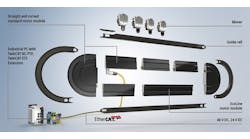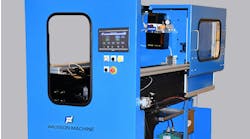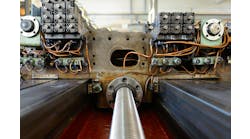In the middle of the COVID-19 epidemic and while the world is learning how to keep our distance from each other for survival, it is ironic that the topic for this column is linear measurement. Please, be safe out there.
Automation has always involved knowing where an object is at a particular moment in the process. Simple movement can be determined by sensing the location of the device at the beginning and end of its intended path. Rotary motion can be determined by the use of an encoder to decode angular movement and translating that into degrees or radians. Rotary motion can be converted into linear motion by applying a gearbox and some pulleys to the rotary shaft.
Some math will give you a relationship between rotation and linear travel. Let’s dive deeper into how to measure linear motion.
As with any detailed examination of trends in automation, it is good to go back to the beginning. The beginning, in this case, starts with a linear actuator (pneumatic or hydraulic cylinder) and digital sensors (proximity switches usually) to indicate start and end points of motion.
Sensors can be any of the typical types. A limit switch, proximity switch, reed switch or photoelectric switch is the more common types.
[javascriptSnippet ]
[pullquote]Always remember that it is better to detect the position of the driven object, rather than the driver. The reason for this is fairly simple, a clevis might come apart or a guide jams up and the driver (actuator) might make it to the fully extended or fully retracted position but the driven object may not.
Sensing other positions along a linear plane of travel can also be done using digital switches. While not as practical for full stroke devices, intermediate sensors might be of value for proportional valves where multiple stop positions can be sensed and maintained.
Beyond the techniques discussed thus far, the real desire with linear movement is to know the exact position along a linear path at any given moment. For this to happen, we have to resort to analog signals or encoded position feedback.
The definition of linear measurement is the distance between two given points or objects. For example, one might measure the length of a table by using a yard stick and start at one end of the table and note the point at which the yard stick meets the opposite end of the table. In a controls environment, we don’t have the ability to extend a measuring stick across a span and get a value in return but we do have something more practical. We have at our disposal a variety of means by which to convert a distance into an analog value.
An early method of linear measurement evolved from the need to measure length travel over a longer distance.
Called a draw wire, the concept is rather simple. Pull a string out with the movement of the object and pull the string back in as the object retracts. The string or rope is wound around a spool and a potentiometer is attached to the spindle of the spool. The voltage output via the potentiometer represents the amount of string played out. While creative, the accuracy was only good if a single layer of string is displaced.
As one can imagine, multiple layers means a different circumference with respect to a turn of the potentiometer. To be most accurate, the entire length of the string would have to be contained in a single turn of the spool.
Another example of a linear sensor would be a photo-electric switch with analog feedback. Light is transmitted by the photo-sensor, bounced off the object in motion and received back at the receiver of the sensor.
By means of triangulation, the sensor can detect the distance of the object from the light transmitter. Earlier versions of this sensor would have used diffused light while newer versions rely on the much more finite beam of a laser to make use of this multi-pixel technology (MPT).
A newer, more accurate version of this methodology employs pulsed light to determine distance. The speed of light is a constant, so the time between the sent pulse and the received pulse can be directly related to the distance the pulse of light travels to and from the object. Dividing this result by two gives us the distance. This technology is referred to by one vendor as pulse ranging technology (PRT).
A technology that has been around for years is linear variable differential transformer (LVDT). The basic principle is to put a pair of coils around a ferromagnetic core. The first (primary) coil is in the middle and the opposite (secondary) coil is split to be upstream and downstream of the first coil.
An alternating current drives the primary coil and induces a voltage in the secondary coil that is proportional to the length of the core linking to the secondary. If the core is exactly in the middle between the secondary coils then the voltage output is equal and, therefore, negating.
Moving the core from one end of the travel to the other will produce a positive net voltage through a zero net voltage to a negative net voltage. This voltage is directly proportional to the distance traveled by the object connected to the core.
The great thing about an LVDT is the output is absolute. If the power is shut off then the same relationship exists between the primary and secondary coils when power is restored so it will give the same result representing position.
Another great thing about an LVDT is that the use of a magnetic core and an induced voltage means that the core “floats” in the tube and, as such, has no friction to impede the accuracy of the device.
Linear measurement techniques continue to use the three principles described in this article. As with any technology however, improvements are constantly being made.
Many vendors offer variations of linear encoders. In one such application, an encoder is calibrated to represent the full travel of the linear device. Photoelectrical scanning is at the base of this method.
A sensor reads fine grooves etched into a substrate material (usually glass, steel or steel strips) and interpolates that into position feedback. The grooves are applied in a lithographic manner and graduations from 40µm to 1µm are possible, providing a high degree of accuracy.
Another variation, called an exposed linear encoder, uses the laser Doppler principle in a new and innovative manner. A camera-based bar code reader determines position based on a bar coded tape. Resolution as small as 0.1 mm and precise positioning up to 10 meters are possible. The use of a camera means it is wear- and maintenance-free. Speeds up to 10m/s are attainable.
These devices, available with a variety of communications protocols, makes them a great way to accurately determine length and the use of bar code technology means linear measurement can be accurately reported regardless of straight or curved travel.
Highly accurate measurement techniques like those above are essential to precision movement applications like CNC machining and micro-machining used in the production of semi-conductor products.
As one can imagine, the need to move with an accuracy of +/- 1mm requires a different degree of position feedback than the requirement to repeatedly execute a movement of microns on the substrate of a semi-conductor used in electronics.
As with many parts of life, the more things change, the more they stay the same. In the field of controls design, just because something was invented a long time ago, it doesn’t mean it can’t be improved upon.
Innovations in technology often provide a means by which to breathe new life into a solid concept. Linear measurement has come a long way from the days when a series of independent sensors were used to provide feedback on travel in a straight line. Today, even a curve can be resolved into a series of straight lines with a great degree of accuracy and repeatability. Technology will continue to move forward with every increasing resolution. Greater things in smaller packages always stimulating the creative process.






